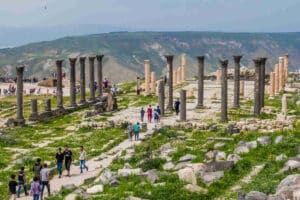Petra was a Nabataean city in which tombs figured prominently, as any visitor can understand today. In fact, for a long time it was thought that Petra was not a city but simply an immense necropolis full of tombs. Of these, the Royal Tombs of Petra are perhaps the most prominent. We dedicate this post to them, but also to other burial places that are interesting for their history, location or beauty.
What are the Royal Tombs of Petra and where are they?
The Nabataeans They did not stand out as great architects, but they did stand out as Magnificent SculptorsThey soon discovered that the soft sandstone of their canyons and cliffs could easily be worked to create artificial caves in which to place dwellings (although most were tents like that of the Bedouins), premises, temples and, above all, tombs.
To them they devoted great efforts and their best decorative resources. Most had not only burial chambers or loculi (niches) in which to insert bodies, but also other rooms for meetings and events related to the deceased. Although these spaces have come down to us with the ‘naked’ stone, it is known that they were covered with plaster and polychromed.
Of these, the Royal Tombs of Petra are the best concentration of funerary monuments in this city. To get there, you have to leave the Treasury and the Theatre behind, so they are in the very heart of the venue.
As its name suggests, this spectacular row of tombs is associated with rulers or kings of Petra, although archaeological evidence has not shown who exactly they belonged to, as there are no longer any elements associated with their deceased. In any case, they can be dated between the first century B.C. and the second century A.D., when this civilization reached its peak.
What does remain and can be admired is the rich exterior decoration of the façade. The main typologies of Nabataean tombs are represented here, in some cases truly original and, in others, clearly inspired by the Ptolemaic architecture of Ancient Egypt, especially that of the city of Alexandria. In this sense, we can find tombs with merlons and steps, tombs with pediments and pilasters and the so-called classical or classical-complex tombs, with a wide variety of elements.
The most famous are:
- The Tomb of the Urn, so called because of the huge urn on its pediment. It is believed that it may have been the burial place of King Malichos II or Aretas IV
- Silk Tomb, so called perhaps because of the refined appearance of its rocks and veins
- Corinthian tomb, very Hellenizing
- Tomb of the Palace, due to its palatial appearance
Other tombs in Petra
Although the row of Royal Tombs of Petra are the most prominent, they are not the only ones, far from it: scattered throughout the rest of the enclosure there are many others, some even more spectacular and famous. Here are some of them:
- The Treasure (Al-Khazneh): without a doubt, the most famous, authentic sign of identity and tourist attraction of this destination. It may also have been the burial place of the aforementioned Aretas IV
- Tomb of Sextus Florentine, for a Roman governor of Arabia
- Tomb of the Roman Soldier, named after the statue in front of it
- Garden Tomb, which may have been a temple
As you can see, beyond the Royal Tombs of Petra there are many others scattered throughout the territory that allow us to understand the religious and artistic universe of the Nabataean civilization. So if you’re going to come here on a trip, open your eyes wide and get ready to discover a unique place that still radiates spirituality today.



